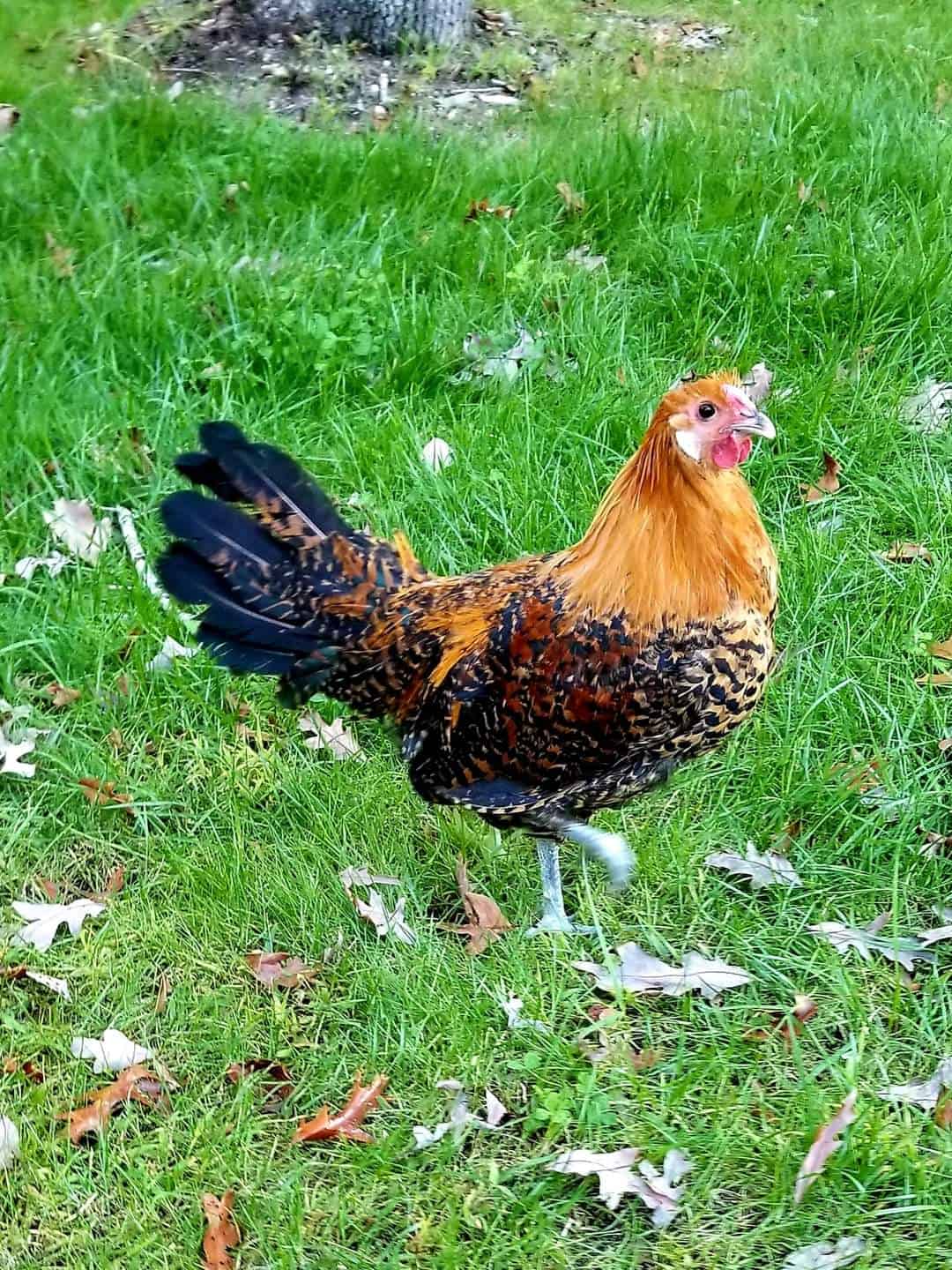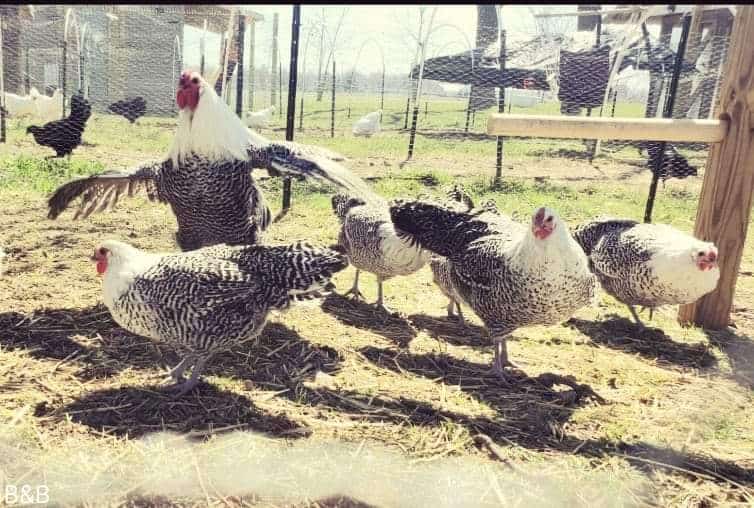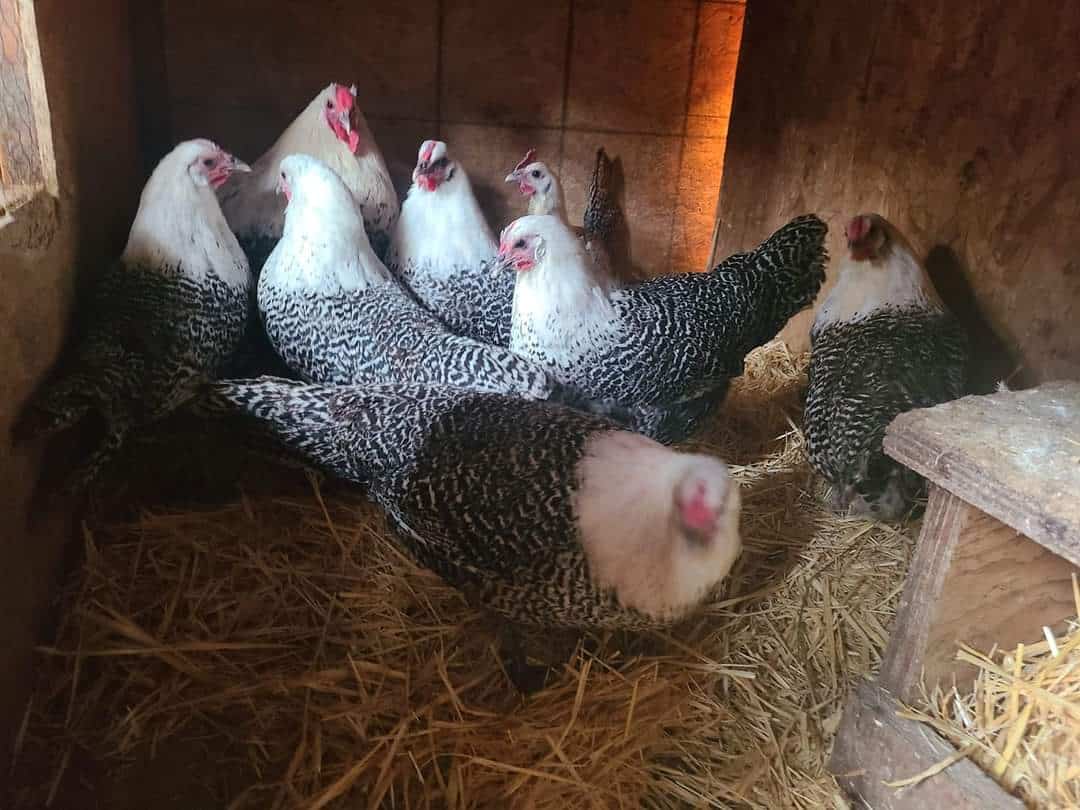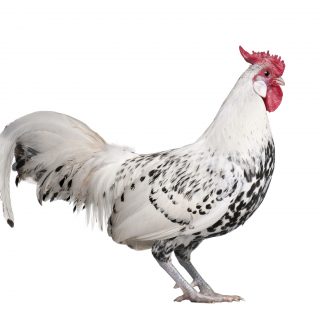Deathlayer Chickens (also known as known as Westfälische Totleger) are originally from Germany. They are proficient egg layers who are known to lay eggs until they die.
If you are looking for a rare, beautiful and unique chicken breed to add to your flock, a Deathlayer chicken might be just what you need. Other than the obviously cool name, this breed is also a good egg layer that lays well into older age. They tend to be an easy to care for chicken as well.
They are a small to medium sized bird which lays medium sized white eggs several times a week; up to 200 in a year!
Though they may not lay quite as well as their name implies, they are a decent egg laying addition when choosing a breed for your flock.
Is this metal named chicken going to lay to the death? Read on to find out the answer to that as well as their temperament and care needed to see if this is a breed that is right for your flock.

Deathlayer Chickens
| Size | Males: 5lbs; Females: 4lbs |
| Class | N/A |
| Color | Silver and Gold |
| Temperament | Active |
| Hardiness | Cold & Heat |
| Eggs/Yr | 150-250 |
| Egg Size | Medium |
| Egg Color | White |
| Life Span | 5 to 8 years |
History & Origin
This breed is considered a rare breed and originate from Germany. There is not a ton on their history available, and some of it is questionable.
It is said that they got the name Deathlayer through translation of their German name Totleger. And, though Tot does mean dead in German, it is more likely that the Deathlayer name came about due to slight German name variations over time (source: Wikipedia).
As for how long chickens lay eggs, most chickens will taper production greatly at just a few years. Due to their name, they are rumored to lay eggs throughout their life until the day they die. And, while this may be true, there are no actual records of this fact.
In any case, however the name came about, it is definitely an eye-catching, hardcore metal chicken name if there has ever been one!
Deathlayer chickens were originally imported to the US from Greenfire Farms. Who first brought in the silver penciled and then the gold penciled coloring. Since then, they have started to grow in popularity in the US due in part to their stunning look and also in part due to their fantastic name.
What Do They Look Like?
This breed comes in both Silver Penciled and Gold penciled coloring. Both are stunning colors and make for a very eye catching addition to your flock.
Penciled coloring is the pattern on the birds feathers. And then silver refers to the overall color of the bird being silver. And gold refers to the overall color being a gold deathlayer.

They have a rose comb which is red to match their medium sized red wattles. Their legs are slate or blue-grey with four toes on each foot. They are clean legged, unlike Marans and Silkies.
Need some help keeping your chickens health and care taken care of? Check out the Organized Chicken Keeper for an easy to follow system.
Breed Standards
This breed is not accepted by the APA, so there are no set breed standards to speak of. This means that they cannot be shown at APA sanctioned shows.
Temperament
This breed tends to enjoy an active and energetic life. They are great foragers (which is awesome to help keep your chicken feed costs under control).
They also tend to be hardy in both hot and especially cold environments. This combined with with their active foraging makes them a good addition for any flock, particularly if you have room for them to roam.
Here's what some owners and breeders are saying:
According to breeders at H&B Farmstead, "Very beautiful breed that tends to be skittish"
Ben D at B&B Cheek Cheeks: "The roosters are one of the least intelligent out of all the different breeds we have. The girls are very talkative and curious yet always cautious or skiddish....They are very good foragers/free rangers, cold hardy."
Mallory K at K Quarter Circle: "Mine are very friendly and my roo loves to be cuddled, but they can be skiddish as well. My chickens love to eat strawberries."

What is Their Purpose?
Their main use is for their egg laying abilities. They are not a big enough breed to use as a dual purpose chicken. And, since they are not an APA breed, they can only compete in non-APA shows.
They are good, steady egg layers. Usually this breed starts laying around 18 weeks old or so. Make sure you know the signs your chicken is ready to lay so you will know when to look out for your first eggs.
Deathlayers average about 200 eggs per year with some flocks reporting lower numbers closer to 150 and others higher into the 250 range. So, while they are certainly not the egg laying powerhouse of a Leghorn chickens or Amberlink, they do produce a decent amount of medium sized white eggs.
As mentioned earlier, their name insinuates that they will lay eggs regularly until the day they die. And though they may lay more steadily longer into life than other chickens, there is no actual proof for the claim that they will lay right up until death. Though, anything is possible.
Care & Health
Deathlayers tend to be a pretty hardy and need the typical chicken care. Making sure that they have ample room in their chicken coop and run is important due to their high level of energy and activity. Even better if they can free range during the day as they enjoy space to roam and forage.
You'll also, of course need a standard chicken waterer and chicken feeder. But, they don't need anything special here for care.
Due to their small rose comb and small to medium sized wattles, they tend to handle cold well. So, you don't have to do too much extra when caring for these chickens in the winter other than making sure they have a draft free coop.
FAQ
How many eggs do Deathlayer chickens lay?
Deathlayer chickens can lay upwards of 150-250 eggs per year. There seems to be variations in the amounts they lay per week and per year. They are said to lay eggs throughout their life, up until the point they die. Most chickens will taper off after a few years of age.
Are deathlayer chickens cold hardy?
Yes, deathlayer chickens tend to be cold hardy. This is due to their smaller comb size. Most chickens with smaller combs do well in cold weather.
What color eggs do Deathlayers lay?
Silver or Gold Deathlayers lay a white or off white colored egg of medium size.
How much do Deathlayer chickens cost?
This is a rare breed, and much like the cost of other chickens, that greatly increases their price. Day old chicks can range from $25 - $100+ for this breed.
If you need more help with taking care of your chickens, check out The Organized Chicken Keeper for a complete system for managing their health through keeping their supplies stocked and coop clean.


